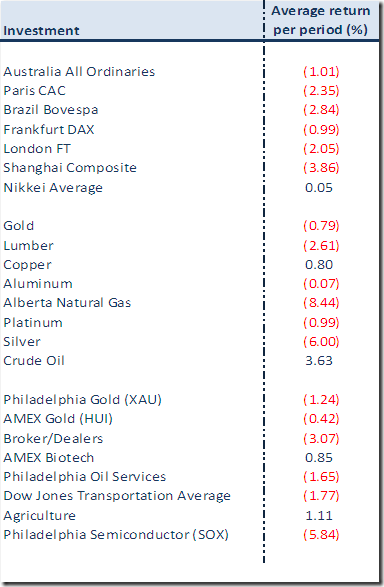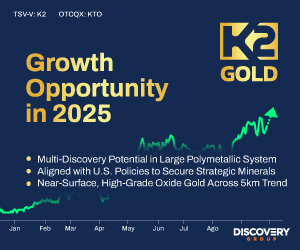The market is like a kid that can only ride a bike with training wheels on it, according to Robert Cohen of GCIC Ltd. As portfolio manager of the Dynamic Precious Metals Fund and the Dynamic Strategic Gold Class Fund (sold in Canada) and the Dynamic Gold & Precious Metals Fund (sold in the U.S.).
COMPANIES MENTIONED: AMPELLA MINING LTD. – AZUMAH RESOURCES LTD. – CANYON RESOURCES LTD. – CONTINENTAL GOLD LTD. – DRAKE RESOURCES LTD. – GRYPHON MINERALS LTD. – OSISKO MINING CORP. – PAPILLON RESOURCES INC. – PERSEUS MINING LTD. – PMI GOLD CORP. – RED BACK MINING INC. –ROXGOLD INC. – TOREX GOLD RESOURCES INC. – VOLTA RESOURCES INC.
Cohen is expecting a new set of training wheels in the form of a third round of quantitative easing. In this exclusive interview with The Gold Report, Cohen suggests that, as fear among investors continues to drive down stock prices, the market is now primed for patient accumulation.
The Gold Report: Robert, British Prime Minister David Cameron said that the European debt crisis could “get a lot worse.” What’s your view on the likely outcome?
Robert Cohen: I think he’s right. It has the potential to get worse before it gets better. Europeans are going to have to deal with some sort of Eurozone fracture. Greece could certainly exit the euro within weeks rather than years. It has an election on June 17, and it will probably be bankrupt by the end of June.
TGR: Can the Eurozone survive without Greece?
RC: It can survive, but other countries could leave or it could break into two parts, like a northern Eurozone and a southern Eurozone.
TGR: Is the debt crisis in Europe a continuation of the 2008 market meltdown?
RC: Absolutely. It’s just another chapter of the global financial crisis. There’s been a buildup of global foreign exchange reserves. I think that’s the root cause of a lot of the problems in the Western world. The foreign exchange reserve buildup globally, probably generated out of China and Organization of Petroleum Exporting Countries, circulated into the developed bond markets of the world.
The whole notion of the Eurozone was poorly planned. It doesn’t give individual central banks the ability to manage their balance sheets to debase their own currencies. Different countries with different economies have the equivalent of one Fed. It’s hard to get decisions made in Europe swiftly and effectively. It’s dysfunctional.
TGR: How long before it spreads to North America—or does it?
RC: We’re all connected to the global economy. It can spread very quickly depending on how interconnected the financial systems are with one another.
TGR: Was JPMorgan’s $2 billion loss related?
RC: I think that was just a rogue trader. However, it still has to be investigated.
TGR: How is what’s happening in Europe impacting your day-to-day fund management? How do you manage against fear?
RC: What’s going on macroeconomically is causing dysfunction in the stock market, but not the underlying metals. I’m actually quite comfortable with the gold price around $1,600/ounce (oz), oil at $95/barrel (bbl) and copper at $3.75/pound.
Paper money is losing its purchasing power. What’s happening globally is creating fear and contagion that’s spreading into the stock market. We’re at a unique place in history where the metal prices are robust and yet the stock prices are the cheapest I’ve ever seen them relative to the underlying commodity prices. It’s a behavioral finance issue. Investors are cranking up the risk premiums and their perception of risk. It’s manifested in the stock prices across the board.
We use quantitative models that statistically measure observations of the stock market. You already know stocks are cheap. The model concludes when stocks are cheap, we should to buy more stocks and less bullion. We run a secondary model that actually brings in other effects, such as the U.S. monetary base. That model has a bit more of a neutral stance between equities and bullion at present. While one of the models is indicating to put the pedal to the metal because equities are super cheap, the other model is saying to ease up slightly. I take a neutral stance between the results of those two models and go 60% equities and 40% bullion in our Dynamic Strategic Gold Class fund, which is still fairly defensive.
The other fund strategy is an all-equity fund. We keep it defensive by owning a tight number of equities. Two-thirds of the fund is in 20 names. The remainder is in another 20–30 names. It’s a very concentrated portfolio. We’ve hunkered it down into our favorite stocks because you could be a genius stock picker and still miss in a market that is being ruled by fear.
TGR: Was there any point in the last 18 months when you wished you could have been invested in 100% bullion in your strategic gold class?
RC: It would have been doing a “George Costanza” of what our models are saying. The models would indicate to go to 100% bullion when the market is over-exuberant on stock valuations. Stocks have undoubtedly been undervalued since 2007.
Our models don’t indicate if the market is going to get more fearful in the next chapter. We can’t predict that. We just observe and allocate accordingly.
TGR: Are precious metals equities still safe havens or is that status all but gone?
RC: Gold bullion and gold equities are two different asset classes. Gold is a monetary asset that works through time. If you wanted to protect your purchasing power, you could have put an ounce of gold in your safety deposit box in 1971 or 16.5 bbl oil in your garage, and today, 41 years later, swapped them at the same ratio. That tells me that gold keeps its purchasing power. Gold is an ideal way to protect your purchasing power—not to mention that barrels of oil in the garage would have taken up a lot of space and been a fire hazard.
We are going through a period of the erosion of the purchasing power of money. We’ve always gone through that—our parents, grandparents. One of the slides I use in my presentations is a bunch of Vancouver kids in 1947 protesting a hike in the price of chocolate bars from $0.05 to $0.08. You can look back on it today at how laughable and cute that is, but it was a serious matter to them. Monetary reflation is constantly chipping away at your purchasing power.
Now, are precious metal equities safe havens? While equities are never safe havens by definition, gold equities can provide the potential for capital appreciation over the long term. However, the last four years have witnessed a change in the stock market functionality. The financial crises unfolding in Europe, fiscal deficits, government debt piling up in the U.S. and global trade imbalances have put a lot of fear into the equity markets. It’s going to bounce along the bottom here for some time. Often quantitative easing (QE) is a trigger to get the market functioning well. In January 2009, after QE1, functionality returned to the market. Then it sort of wore off again. Then QE2 put some more functionality into the market. QE2 has kind of worn off. Here we are, wondering what the governments are going to do next.
We need the functionality back in the stock market. QE could help. The market is like a kid that can only ride a bike with training wheels on it. If the training wheels start breaking or you try to take them off, the kid can’t ride the bike. We need new training wheels right now.
TGR: Are you expecting QE3?
RC: I am, which presents an opportunity in itself between now and the time it comes. It’s a good time to accumulate patiently.
TGR: Most of your top equity holdings in the Dynamic Strategic Gold Class Fund have flagship operations in North America. However, one key holding, Perseus Mining Ltd. (PRU:TSX; PRU:ASX), has an operating mine in Ghana that has been in commercial operation since the beginning of this year. Perseus also has some exploration projects in Côte d’Ivoire. Why is it your second-largest holding?
RC: I like up-and-coming producers with quality assets. Over the years, we’ve bought things like Perseus, Osisko Mining Corp. (OSK:TSX) and Red Back Mining Inc. (RBI:TSX) that were the new kids on the block. They’re gradually transforming into household names.
Perseus’ Edikan mine has been operating for a couple of quarters. It is still working through some of its initial teething problems, but what mine has started up without some sort of teething problems? It’s worked through a lot of the issues. It can produce more than 200,000 ounces (200 Koz)/year from Edikan.
The Côte d’Ivoire is its next leg of growth. That should give it more than 100 Koz/year. It’s a higher grade, so is even more financially robust.
Because this name isn’t a household presence, we see an opportunity. It’s a very well priced stock right now. With the way the stock market is acting now, we still think it’s undervalued given valuations of similar peers.
TGR: How do the cash costs of Edikan compare with similar mines in West Africa?
RC: It’s bang on at around $600/oz. People complain that the costs are going up, but it’s actually one of those good problems to have. If costs are moving up, it probably means the revenue line is moving up, which means the percent profit margin is also expanding. An investor who thinks that the gold price should move up and everything else should stay flat might be disappointed that the profit margin is not expanding. That’s not how things work. You can’t hold your cost line flat and have your revenue line flat. Take it for what it is. It’s an improved profit margin. Be happy about that.
TGR: What do you expect Perseus to do with that tremendous amount of cash flow?
RC: Dividend it out, buy back its shares or find other projects in West Africa to acquire and build. This is the nucleus of an operating company. It could probably take on another project. After all, it’s assembled an engineering, construction and permitting team. It could keep these people perennially busy doing new projects, but in this market, it might be smart to find a good opportunity and get the next leg of growth under its belt.
If it can’t find a project, it can certainly crank up its dividend. That might be another way to get these equities fired up. Some of these companies can afford to pay north of a 5% yield. That could be a catalyst for the industry if they start paying yields that get even grandma and grandpa interested in these stocks.
TGR: What are some of the other stories in West Africa that you’re following?
RC: We’re following quite a number of stories in that region. Geologically, it hasn’t been as well combed over as other parts of the world. Political risk isn’t as bad as the worst places in the world. It’s not a bad risk-to-return ratio. You have to select your countries. There are obviously going to be problems in West Africa, usually infrastructure related—be it power, water or skilled labor. Even with those hurdles, there are some robust projects with decent internal rates of return (IRRs), good payback and relatively fast payback periods. West Africa is where the interesting up-and-coming companies are working.
We’re following Ampella Mining Ltd. (AMX:ASX), Papillon Resources Inc. (PIR:ASX), Gryphon Gold Corp. (GGN:TSX; GYPH:OTCBB), Volta Resources Inc. (VTR:TSX) and Drake Resources Ltd. (DRK:ASX) out of Australia; and Roxgold Inc. (ROG:TSX.V), PMI Gold Corp. (PMV:TSX.V; PVM:ASX; PN3N:FSE), Azumah Resources Ltd. (AZM:ASX), and Canyon Resources Ltd. (CAY:ASX) out of Canada. Perseus is still one of the most advanced ones, so that’s one of our favorites.
TGR: Volta has the Kiaka project in Burkina Faso that has about 4 million oz (Moz) in the Measured and Indicated category and another 1 Moz Inferred. What do you see happening with that project?
RC: I do see a mine at some point, but the share price could do all kinds of weird and wonderful things in the meantime. Investors are putting a lot of extra risk premiums on companies. It doesn’t matter if it has a great project if it’s not yet financed. Volta has to raise the better part of $600 million in equity and debt to build this. I still see a decent payback period of just over three years without even including the discovery at South Kiaka. I see something there that looks financially robust.
The bigger macro picture with Volta, and many other companies just like it that have good projects, is that it has to finance these things. Meanwhile, this is still a project that should be at the top of the shopping list of bigger companies looking for a new project that’s already well advanced in that region.
TGR: I’m sure you have a similar view of Roxgold, but Roxgold is interesting in that its Yaramoko project is a high-grade gold project in West Africa, which doesn’t generally happen. These are generally large, low-grade deposits with an open-pit signature. Have you visited Yaramoko and seen it firsthand?
RC: There is not much to see there other than the drill core. I’ve gone through the drill holes in a lot of detail in multiple meetings with the company and a few of the sell-side analysts who have gone over there, seen it and keep close tabs on it. I look at things like ounces per vertical meter (oz/m). It put down Hole 69 that was about 650 meters (m) deep. It even reported before the assay came in that it saw 34 flakes of gold in the core, which would normally correlate to some sort of high-grade assay. That got the stock fired up.
What is somewhat perplexing is that the grade of that particular hole didn’t return anything all that significant. There was some background grade there. Even the company was a little perplexed. It took the remaining half of the drill core and quartered it just for another round of assay to see if something different comes back. The market reacted quite violently on the downside when Hole 69 didn’t return a high-grade assay.
It would be nice to see more vertical extent on the Yaramoko deposit, but I haven’t ruled anything out yet because it has to do a lot more drilling to understand it. I certainly like what I see in the top 250m, which is one reason why we own it. If this one works out down deep, great. If it doesn’t, the fat lady hasn’t sung because there are still things to look at laterally as well.
TGR: Does it have the right people in place to gain a full understanding of that deposit?
RC: The geologists are good. I’m not one to praise or criticize anyone. Are there smarter people out there who might be able to hone in on the gold faster? Perhaps. I don’t know. I like what I see so far.
That’s what early-stage exploration is all about. We don’t know exactly how this is going to wash out. But as you pointed out, this is high-grade gold in Burkina Faso, which keeps me pretty curious.
TGR: Continental Gold Ltd. (CNL:TSX; CGOOF:OTCQX) owns the Buriticá project in Colombia, which has demonstrated tremendous grade. Intercepts outside of the resource model are sitting at 50 grams per ton in some drill holes. Is the gold going to be easy to recover from that type of mineralogy?
RC: It is actually operating a small mine there right now, so we already know that the gold is easy to recover. These are narrow-vein systems. It will probably use shrinkage stoping in selected areas. Of course, with mining methods like shrinkage stoping, the skill level of the workers goes up commensurately. Colombia doesn’t have a history of underground mining, so it may have to move some skilled Canadians down there to train the locals. But there is enough high grade here for it to still be robust.
TGR: Continental has started work on its preliminary economic assessment at Buriticá. What are you expecting from that?
RC: It’s yet to be seen, but I think we’ll see something that should be more robust than a lot of other discoveries. I think we have the grade. I think we have the vertical extent and continuity. Let’s wrap some real line plans around it. Let’s wrap some real dilution around it and some capital costs for building a plant. Obviously, the higher the grade, the smaller the plant it needs to build, so it should have a good rate of return. I would hope for a rate of return north of 20% after tax.
TGR: Osisko has been topical lately because it missed its first-quarter estimates and had a fire in its mill. That is a low-grade project at first world costs. I think there are a lot of investors on the Street who would say they saw some of these things coming. What’s your view?
RC: I don’t have any issues with the grade. It’s a homogeneous deposit. It’s easy to mine compared to other low-grade deposits. It may have worse start-up problems, but once it’s engineered its way through the mechanical crushing of the ore, it will be up to nameplate capacity. For a low-grade project, it’s still robust. It’s just in the early stages of operating. It has a lot of flexibility, too.
TGR: Torex Gold Resources Inc. (TXG:TSX) is developing the Morelos gold project, which is relatively close to Mexico City. Is that going to be a big cash-flow producer once it’s in operation?
RC: Yes, it’s one of the better discoveries of recent years. It’s into its final stages of engineering and so on. I see a project that should have approximately a three-year payback after tax, so that gives it a fairly healthy IRR and a good long mine life of 11 years.
TGR: Do you believe it’s a takeover target?
RC: If I were running a mining company, it would definitely be at the top of my shopping list.
TGR: Can retail investors still make money when the markets go down and sideways as they have in 2012? If so, what strategies would you suggest?
RC: That’s the million-dollar question. If markets are flat to oscillating, investors can make money with short-term trading, but I don’t encourage that. Like Warren Buffett, I encourage investing in good-quality businesses because just picking the right projects doesn’t guarantee that you’ll make money.
Let’s go back to 2007. Here’s a situation where you can pick the right projects and still lose money. Ron Little’s Orezone Gold Corporation (ORE:TSX), between 2006 and 2008, was a $2/share stock. It had the Essakane project. Fast forward to today. Essakane is now a flagship mine of IAMGOLD Corp. (IAG:NYSE).
It fit the bill as a good project in 2007. An investor would have asked: Is this project robust? Check. Is it something a big company would want? Check. And sure enough, Orezone was actually vindicated. A big company did want it. Is it an operating mine as predicted? A robust mine? Check. But the company wasn’t financed at the time and the share price went down a corkscrew because investors perceived more dilution coming.
When the crisis hit in September 2008, the market took it all the way down to $0.14/share. Then in December of that year, IAMGOLD smartly swooped in and bought it for $0.50/share. The only investors who made money on it were the ones with the stomachs of steel during the crisis. Investors could have checked off every box, but the stock market still killed it.
TGR: Thanks, Robert.
A mining and mineral process engineer by training, Robert Cohen is vice president and portfolio manager for GCIC. His experience in the mining industry is extensive and includes work as an engineer and a corporate development adviser for an international gold mining firm. Cohen completed his Bachelor of Applied Sciences in mining and mineral process engineering at the University of British Columbia in 1992. In 1998, he received his Master of Business Administration and, in 2003, Cohen received his CFA designation.
Want to read more exclusive Gold Report interviews like this? Sign up for our free e-newsletter, and you’ll learn when new articles have been published. To see a list of recent interviews with industry analysts and commentators, visit our Exclusive Interviews page.





















